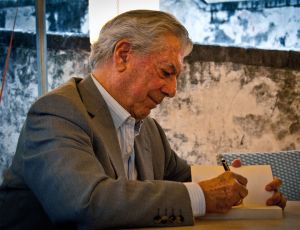I saw a man under the spell of his own tale, a snake charmer whose serpent has become his turban.
I’m not sure how I want to use the above quote, which comes late in the book, but I just liked it and so decided to start this post with it. Bear with me!
Discounting Dinaw Mengestu‘s short story, An honest exit, Abraham Verghese‘s Cutting for stone is the first novel I’ve read that’s set in Ethiopia (mostly). And for that, as much as for anything else, I enjoyed it. Also, in one of those eerily frequent experiences of reading synchronicities, this is the second book that I’ve read this year to deal with a long-standing dictator – and, even more eerie, is the fact that dictators in Africa are falling (sort of) around our ears at present. How do these things happen?
Anyhow, Cutting for stone is about as different from Mario Vargas Llosa‘s The feast of the goat as it could be. In the latter, dictator Trujillo is central to the story. He is the story really. In Cutting for stone Haile Selassie, and later Mengistu, provide the background. The characters are touched and, eventually, significantly affected by coups and unrest, but Selassie and his reign are not the subject of the novel.
So what is its plot? It is mostly set in an Ethiopian hospital, aptly, metaphorically, named Missing (a perversion of its original name, Mission). To this mission hospital come an English surgeon (Thomas Stone) via India and a young Indian nun (Sister Mary Joseph Praise), with rather cataclysmic results. Some time later (I’ll leave you to draw your conclusions) identical conjoined male twins named Shiva and Marion are born. The story follows their lives as they grow up, living through political upheavals while their adoptive parents, Hema and Ghosh, treat the sick and poor of the region, until one of them moves to the United States. Perhaps the best way to describe it is to quote Psychologies from the back cover: “a sweeping saga of family life, love, betrayal and redemption”. Get the picture?
This is a traditional nineteenth-century-style novel, reminiscent, say, of Rohinton Mistry‘s A fine balance (1995). It’s about social conditions and family. The back cover (again) suggests it has flavours of Dickens and Waugh. Perhaps, but a weak flavour I’d say. While it has some of the intensity of those writers, it lacks their bite. I also found the fundamental crisis – which, not surprisingly given the set-up, has to do with a betrayal between the twins over a woman – to be not quite convincing. Maybe it’s me, but the narrator kept telling us of his love for the girl-then-woman in question, Genet, and I went along with it to a point. But it was never made clear how mutual this was. Marion is the narrator – this is a first person tale – and so we see it all through his eyes, but the whole “love” storyline did feel a little bit like a house of cards. Perhaps that’s the point? Perhaps it’s about his obsession regardless of whether it was realistic or not. It is, after all, partly a coming of age novel.
Verghese, like his main characters, is a doctor and so there is a lot of detail about things medical – about vena cavas and how they relate to the liver, about fistulas in circumcised women, about volvulus, and so on. More detail really than I needed, and yet most of it was interesting. What was even more interesting was the difference between the medical system in Africa and in the United States, and then the difference in the United States between the “Mayflower” hospitals and the “Port Ellis” hospitals. There are social messages here about the construction of medicine in the developed and developing worlds, and between the haves and have-nots. But this wasn’t the only message. According to Wikipedia, Verghese is passionate about “bedside medicine” and there is certainly a strong message here of caring for patients as well as treating them. Early in the novel the young Marion sits with a woman, Tsige, as her son dies. Much later, he is the one who can answer Thomas Stone’s question “What treatment in an emergency is administered by ear?”. The answer? “Words of comfort”.
Marion, then, as a child and a young doctor is well attuned to the feelings of others and yet he was unable to forgive all those who “wronged” him – Genet, his brother, and his birth father. I found that somewhat inconsistent with his character, and it affected my ability to fully buy into the angst on which the plot turned.
Nonetheless, I liked the characters and so I kept reading, the story was interesting and so I kept reading, the writing was fine and so I kept reading. It doesn’t quite hang together, is a little melodramatic at times, but it’s a lively tale about characters I couldn’t help caring about. Early in the novel, we are told that Hema, who raises the twins, had:
come close to defining the nameless ambition that had pushed her this far: to avoid the sheep life at all costs.
The novel is full of characters who “avoid the sheep life”.
I started the review with Marion’s description of his father telling the painful tale of his life. I’ll end with the advice Marion’s adoptive father gives him:
The key to your happiness is to own your own slippers, own who you are, own how you look, own your own family, own the talents you have, and own the ones you don’t. If you keep saying your slippers aren’t yours, then you’ll die searching, you’ll die bitter, always feeling you were promised more…
Obvious stuff really, but that doesn’t mean that it doesn’t need to be said.
Abraham Verghese
Cutting for stone
London: Vintage, 2010
541pp.
ISBN: 9870099443636

